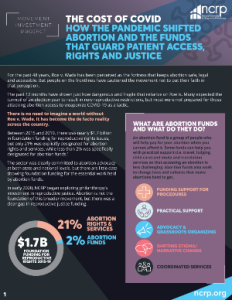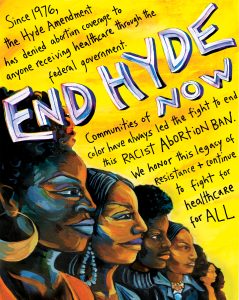 In early 2020, NCRP began exploring philanthropy’s investment in the reproductive justice movement and those providing services on the frontlines.
In early 2020, NCRP began exploring philanthropy’s investment in the reproductive justice movement and those providing services on the frontlines.
The reason was simple: Increasingly restrictive state legislation, a more conservative U.S. Supreme Court and an emboldened Trump administration that prioritized attacks on autonomy and access seemed to predict an end to the legal protections that are supposed to keep abortion safe, legal and accessible for all those seeking services.
A new year and a new presidential administration might signal greater cooperation with federal agencies, but it doesn’t eliminate the intense anti-abortion challenges that are still coming from state legislators or in the courts.
Reproductive rights are also inexorably intertwined with economic justice, racial justice, immigrant rights and health equity. As such, it’s a natural extension of our Movement Investment Project focus on how philanthropy can serve as a better ally to frontline social justice movement activists and organizations.
While over the coming year we plan to delve more deeply into the full array of issues encompassed in reproductive justice, the use of the pandemic as a pretense for anti-abortion policies, the funding patterns for this aspect of the movement and the increased pressure on state and local abortion funds made us decide to start our work here.
The reality of the reproductive access funding space
It’s hard to imagine a just and equitable world that doesn’t allow for people to have full control over decisions related to their body. While the sector is clearly committed to abortion advocacy at both state and national levels, there is little data showing foundation funding for the essential work held by abortion funds.
Why is that important? Unlike some other movements, a significant majority of the financial support for abortion access and services comes not through institutional foundations, but through smaller abortion funds that often struggle to keep up with the financial needs of patients.
In fact, less than 3% of the $1.7 billion of philanthropic dollars for reproductive rights issues between 2015 and 2019 was specifically designated to these abortion funds. Overall, only 21% was explicitly designated for abortion rights and services.[1]
We reached out to abortion funds around the country to better understand how they are providing the practical support callers needed and how a shift in funding would benefit their sustainability and capacity. (We summarized the data and these conversations, with a focus on 5 abortion funds in Southeast, Northeast, Southwest, Midwest and Northwest, in this fact sheet.)
What we heard won’t come to a surprise to many who have sought to access the reproductive rights that the Supreme Court first upheld 48 years ago in Roe v. Wade.
The need to make access real and affordable
There is no need to imagine a world without Roe v. Wade. It has become the de facto reality across the country.
It has come into existence by those who have seized on the restrictions imposed to curb the spread of COVID-19 to further limit access abortion-related services and procedures. Consider that across the nation:
- 12 states have attempted to shut down abortion clinics by labeling them as “nonessential businesses,” with Texas, Ohio, Arkansas and Iowa restricting or banning abortion altogether during the pandemic.
- 19 states have banned telemedicine, limiting both the overall number of clinics and states with clinics accessible to out-of-state patients.
- 33 states require counseling before an abortion procedure, and 25 of these states have waiting periods of at least 24-hours, forcing potential patients to make multiple trips or arrange travel for multiple days at a time.
The restrictions have also limited the work of volunteers and increased overall costs, straining regional networks of volunteers and providers that patients rely on for logistical, economic and social support.
“In the past we have relied on a network of volunteers who could house callers in their home while they were traveling for abortion care as well as provide rides to folks who needed to get to and from their appointments,” says Iris Alatorre of the Northwest Abortion Access Fund. “After COVID-19, relying on our volunteer network for these necessary services was no longer a safe option.”
What should philanthropy do?

Art created by Forward Together staff, Diana Lugo-Martinez, Kara Carmosino and Micah Bazant, to mark the 43rd anniversary of the Hyde Amendment. Used under Creative Commons license.
Money certainly helps, as increased investment in abortion funds would help frontline groups and networks address the continuing uncertainty as the pandemic and anti-abortion legislation leaves abortion advocates under protected and overwhelmed.
It would also allow funds to further accommodate patients through increased partnerships with other organizations to better coordinate both logistical needs like housing and travel as well as mental health needs and services across states to better support those who live in restrictive regions.
The math is not complicated. We know that if abortion funds saw an increase equal to even 1% of all reproductive rights funding, this would mean an additional $9 million in foundation support for the frontlines. However, maximizing the impact of additional dollars would also require a shift in funding practices in the following ways:
Wielding power: Philanthropy must leverage its reputation, financial assets and capacity to destigmatize abortion, empower abortion funds and secure access for those seeking services.
Unrestricted and multi-year grants: Abortion funds rely on 5 primary funders that make up 74% of their philanthropic support. If they were to lose their top institutional funder, it would compromise half of their philanthropic support, a risk that multi-year, unrestricted grants have the potential to reduce.
Funding at the state and local level: At the moment, the top 20 recipients of reproductive rights funding are all national organizations, while a majority of abortion services and practical support are happening at the state and local level.
Transparency from the sector: Philanthropic transparency is vital in not only building trust with a movement that is rightfully cautious, but to disrupt the harmful practice of anonymously funding such a visible issue.
Divestment from fad-funding: Short-lived funding inspired by a historic moment or the fear of abortion restrictions is a harmful practice and doesn’t allow abortion funds to build their capacity.
In many ways, the situation at hand is a vivid reminder that grantmaking reflects an erroneous assumption of reproductive rights as an exclusively white, cis-woman issue centered on the national legal debate is not a framework sufficient to meet the current challenge, much less those that lie ahead.
To equitably serve communities, philanthropy must move beyond the mainstream feminist funding approach that, among other things, privileges legal advocacy over direct support on the ground, negates the links between economic justice and reproductive rights, and often renders invisible the existence of trans and non-binary people as patients needing abortion services and care.
Only a truly inclusive and intersectional reproductive justice funding framework allow us to move us closer to the social change we all wish to see.
Brandi Collins-Calhoun is NCRP’s senior movement engagement associate and leads the organization’s Reproductive Access and Gendered Violence portfolio of work.
Stephanie Peng is NCRP’s senior associate for movement research and was the lead researcher on the organization’s most recent factsheet, The Cost of Covid: How the Pandemic Shifted Abortion and the Funds that Guard Patient Access, Rights and Justice.
1Editor’s Note: Analysis of original figures initially published in January of 2021 concluded a total of 912 million in funding for reproductive rights issues, with 20% going to abortion services and 2% going to abortion funds specifically. However, new data added into the Candid database in late 2021 updated those figures.














































































































































































































































































































































































































Leave a Reply